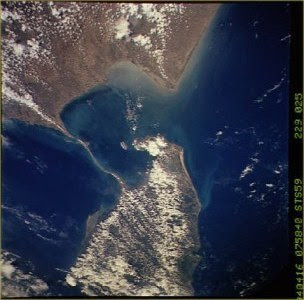Bridge of Rama is about the coming of age of Hanuman. The little vanar warrior from Armies of Hanuman has been entrusted with enlisting to Rama's aid, the biggest vanar fighting force in history. An army that will raze Lanka to the ground and rid the world of rakshahas forever.
Rama and Lakshman wait at the southern tip of the continent waiting for this force to appear. They face the ocean and the 100 miles to the Lankan landmass seems like an unsurpassable distance. The vanars, as a race, are afraid of the ocean and Lakshman is less than confident about the fighting skills of this undisciplined "army" in the face of the most formidable and ruthless warriors on prithvilok. And then, Hanuman arrives.
No one recognizes Hanuman. He, in no way, resembles the scrawny little vanar who met Rama at Janasthana in the previous book. Through a secret transformation, yet to be revealed, he is as tall as a man, powerfully muscled and the paragon of strength. And he brings with him, a janaya-sena, a generation army. It is army that consists of every vanar, man, woman and youngling, capable of fighting. Every vanar in existence is pressed into service with only one objective in mind, the liberation of Sita. And in addition, he has a surprise, a massive army of rkssas or bears, one of the most powerful creatures in the animal kingdom.
Simultaneously, we also follow how Sita's coping in Lanka as a prisoner. Ravana's trying his best to seduce Sita by being an understanding and almost sympathetic captor. Mandhodhari, on the other hand, has a different view of Sita and sees her as a seductress who's got evil designs to be the next Lankan queen.
The vanar-rksaa army begins trying to build the bridge of Rama from the southern tip of the Indian continent to Lanka. This is a hugely challenging task as hundreds of animals push massive boulders in an attempt to make the passageway. However, during one such move, a boulder comes loose and starts tumbling towards Rama. Hanuman, seeing this, manifests a power whereby he expands himself to triple his size and saves Rama. He says he doesn't know how he did but that it was by thinking of Rama that he could. At this point, Jambavan, the king of the bears reveals that Hanuman is no ordinary vanar. He is the child of Vayu, the wind god and the apsara, Anjani. He is, in essence, a demi-god, and it was his devotion for Rama that awakened his power.
That night, as the army sleeps, Rama is visited by the spirit of Dasaratha, who tells him that if Rama did not save Sita the same night, she would perish and the bridge and the army would be for naught. Rama then asks Hanuman to fly to Lanka to bring back his bride.
Hanuman, using his newfound power, grows himself to a hundred times his size and leaps over to Lanka to rescue Sita.
The rest of the book details Hanuman's encounted with Sita and Ravana and the havoc he wreaks on behalf of Rama. His decimation of Rakshasha legions and his threat to bring an army back that would reduce Lanka to rubble.
I'm almost done with the set. I'm on Book 6 now, The King of Ayodhya. :)
By the way, one curious little side-note to this post. I was looking up Rama's Bridge on Google and I came across this.
These are aerial and satellite images of Adam's Bridge or Rama's Bridge that "is a chain of limestone shoals, between the islands of Rameswaram, off the southeastern coast of Tamil Nadu, India, and Mannar, near northwestern Sri Lanka. Geological evidence indicates that this bridge is a former land connection between India and Sri Lanka."
It was reportedly passable on foot till the 15th century at which time, storms deepened the channel. Which kinda makes you think, doesn't it? :)
This entry was posted
on Saturday, February 13, 2010
at Saturday, February 13, 2010
and is filed under
Book Review,
Bridge of Rama,
Ramayana
. You can follow any responses to this entry through the
comments feed
.






